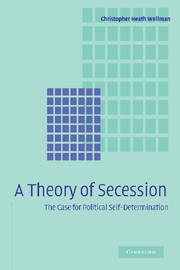Book contents
8 - The Velvet Transformation
Published online by Cambridge University Press: 18 July 2009
Summary
If there is any truth to Kant's bold prediction that democracies will not go to war with one another, it merely puts the icing on the cake of democracy. People already appreciate that the importance of self-determination gives constituents a right to democratic governance, so Kant's predicted consequences merely buttress the already decisive case in favor of democracy. In stark contrast, secession appears to lack not only the icing but also the cake on which to put it. People generally deny that self-determination gives constituents the right to determine the contours of their political boundaries, and the horrific consequences one could imagine resulting from licensing unilateral state breaking appear to defeat any case that might be made on behalf of secessionist rights. This book is first and foremost about making the case for the moral right to secede, but, in the spirit of Kant, I would like to close with my own hopeful prediction: We are not far from the day when political theorists and international actors respect the importance of political self-determination, and when that day arrives, groups will not vote in favor of secession.
The international community is in the midst of a breathtaking “velvet transformation,” a transformation that features the dramatic ascendance of regional and global integration, international law, democracy, human rights, group rights, and self-determination. Even the keenest observers of international relations are surely surprised to see how quickly and extensively these emerging phenomena are taking root, spreading, and profoundly changing the geopolitical terrain.
- Type
- Chapter
- Information
- A Theory of Secession , pp. 181 - 186Publisher: Cambridge University PressPrint publication year: 2005



